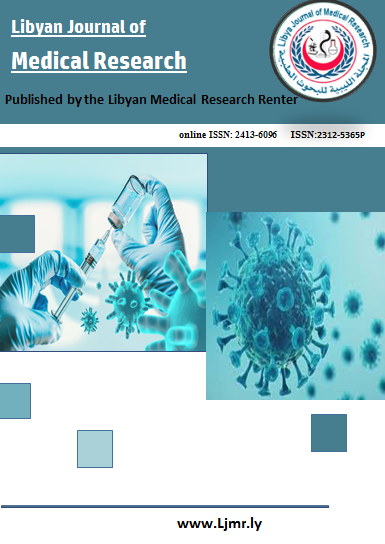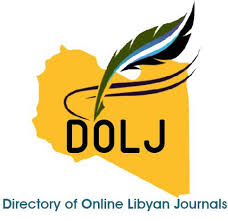Evaluating the levels of physiological variables for patients with kidney failure and diabetes attending the Kidney Disease Center in Zawia city
DOI:
https://doi.org/10.54361/LJME.19.1.18Keywords:
hematological alterations, kidney failure, diabetes, glycated hemoglobin (HbA1c)Abstract
Purpose: The study aimed to investigate the relationship of diabetes to kidney failure and prospective changes between the genders (males and females) attending the Kidney Disease Center in Zawia city
Methods: The study sample included 50 cases (25 males, 25 females), Seven physiological variables (normal sugar, creatinine, chloride, cumulative sugar, urea, sodium and potassium) were evaluated.
Results: The results of blood tests showed that there are no statistically significant differences between the average results of males and females with regard to HbA1c, urea, sodium (Na+), and potassium (K+). The result of (P) were P value = 0.132, 0.121, 0.618, respectively at the confidence level (P ≤ 0.05), while the result of analyzes of fasting sugar, creatine and chlorine showed statistically significant differences; The significance reached 0.003, 0.000, and 0.044, respectively, and they were all less than the (0.05) significance level.
Conclusion: Diabetes is one of the diseases that humans live with, but its complications cause many serious diseases. The gender test showed that there was no difference between the average ranks of males and females in the variables of normal sugar, creatinine and chloride, meaning that all of these variables were less than the 5% significance level, while the rest of the variables were all greater than the 5% significance level, and this was for both male and female groups.
Downloads
References
Abideen, H. A. H., & Elwefa, A. H. (2022). 1- Prediabetes: a high-risk condition for developing the disease. Journal of Pure & Applied Sciences, 21(3), 18-25
Al-Suwayda, Abdul Karim Omar: The Comprehensive Guide for Patients with Kidney Failure, 2010, Glow of Life Publishing and Distribution, 99 pages. First edition.
Bahjat Abbas (2002), Diabetes and living with it, its symptoms, and treatment, with a brief study on gene therapy and progenitor cells, Dar Al-Shorouk for Publishing and Distribution, Amman - Jordan, first edition.
Fatima Matouq, Ikhlas Haiba Omar and Heba Ali Arhaim (2018) Study of changes in biochemical and blood parameters in diabetic patients, Sebha University, College of Science, Department of Zoology.
Ignacio. C. (2002) diagnosis, Classification and Pathogenesis of Diabetes Mellitus. Rev Esp Cardiol ;55(5):528.35. p528-538.
Mahmoud Ahmed Fikri, Suzan Ezzedine Mahmoud (2012) A Clinical Study of Myeloperoxidase and Some Biochemical Variables in Diabetics, College of Science, University of Mosul, Journal of Al-rafiddin Sciences, Vol. 23, Issue 3, pp. 128-145.
R. Hamoudi, N. S. Sharif-Askari, F. S. Sharif-Askari, S. Abusnana, H. Aljaibeji, J. Taneera, and N. Sulaiman, (2019) "Prediabetes and diabetes prevalence and risk factors comparison between ethnic groups in the United Arab Emirates.No.25;(1)17437.
Roberto P.‑F., Hugo A., Carolina C. R., Alisson D. M., Erika B. P., Márcia Q., João E. N., Silvia T. and Sergio Vencio, (2016). Interactions between kidney disease and diabetes: dangerous liaisons. Diabetol Metab Syndr, 8(50):1-21.
Sakina Abu Zeid Said Abu Zeid, Asma Mohammed Ahmed Khamaj (2019) Study of some physiological changes associated with chronic renal failure and their negative effects on patients with kidney failure, Journal of the College of Education, Issue 14, pp. 331-346.
Downloads
Published
Issue
Section
License
Copyright (c) 2025 Hanan Mohamed Kashim, Sara Bashir EL-Hengary, Abdulali Khalifa Taweel (Author)

This work is licensed under a Creative Commons Attribution-NonCommercial-NoDerivatives 4.0 International License.
Open Access Policy
Libyan journal of medical Research (LJMR).is an open journal, therefore there are no fees required for downloading any publication from the journal website by authors, readers, and institution.
The journal applies the license of CC BY (a Creative Commons Attribution 4.0 International license). This license allows authors to keep ownership f the copyright of their papers. But this license permits any user to download , print out, extract, reuse, archive, and distribute the article, so long as appropriate credit is given to the authors and the source of the work.
The license ensures that the article will be available as widely as possible and that the article can be included in any scientific archive.
Editorial Policy
The publication of an article in a peer reviewed journal is an essential model for Libyan journal of medical Research (LJMR). It is necessary to agree upon standards of expected ethical behavior for all parties involved in the act of publishing: the author, the journal editorial, the peer reviewer and the publisher.
Any manuscript or substantial parts of it, submitted to the journal must not be under consideration by any other journal. In general, the manuscript should not have already been published in any journal or other citable form, although it may have been deposited on a preprint server. Authors are required to ensure that no material submitted as part of a manuscript infringes existing copyrights, or the rights of a third party.
Authorship Policy
The manuscript authorship should be limited to those who have made a significant contribution and intellectual input to the research submitted to the journal, including design, performance, interpretation of the reported study, and writing the manuscript. All those who have made significant contributions should be listed as co-authors.
Others who have participated in certain substantive aspects of the manuscript but without intellectual input should only be recognized in the acknowledgements section of the manuscript. Also, one of the authors should be selected as the corresponding author to communicate with the journal and approve the final version of the manuscript for publication in the LJMR.
Peer-review Policy
- All the manuscripts submitted to LJMR will be subjected to the double-blinded peer-review process;
- The manuscript will be reviewed by two suitable experts in the respective subject area.
- Reports of all the reviewers will be considered while deciding on acceptance/revision or rejection of a manuscript.
- Editor-In-Chief will make the final decision, based on the reviewer’s comments.
- Editor-In-Chief can ask one or more advisory board members for their suggestions upon a manuscript, before making the final decision.
- Associate editor and review editors provide administrative support to maintain the integrity of the peer-review process.
- In case, authors challenge the editor’s negative decision with suitable arguments, the manuscript can be sent to one more reviewer and the final decision will be made based upon his recommendations.














